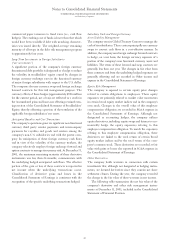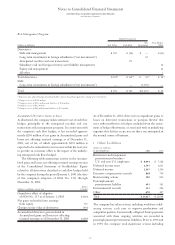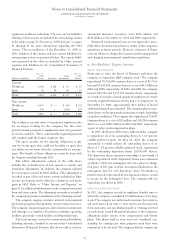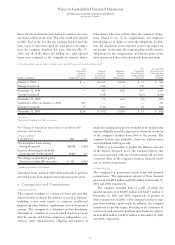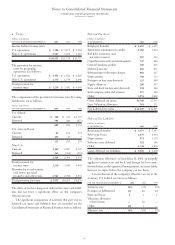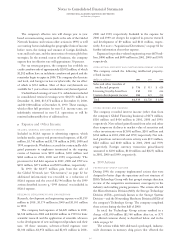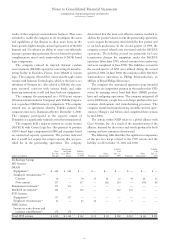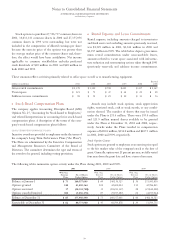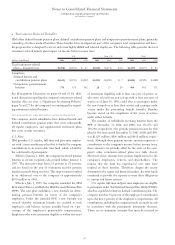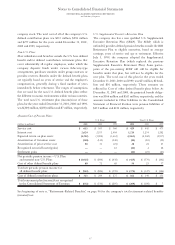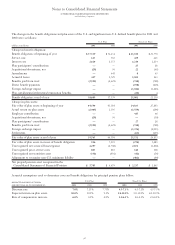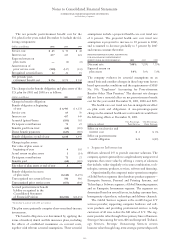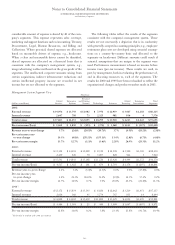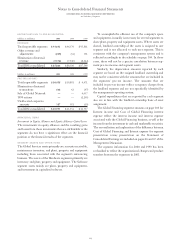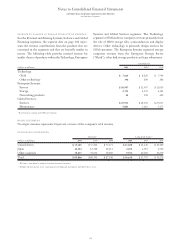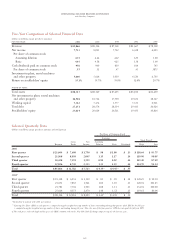IBM 2001 Annual Report Download - page 98
Download and view the complete annual report
Please find page 98 of the 2001 IBM annual report below. You can navigate through the pages in the report by either clicking on the pages listed below, or by using the keyword search tool below to find specific information within the annual report.
Notes to Consolidated Financial Statements
INTERNATIONAL BUSINESS MACHINES CORPORATION
and Subsidiary Companies
96
of retirement eligibility with at least one year of service, or
who were at least forty years of age with at least ten years of
service as of June 30, 1999, could elect to participate under
the new formula or to have their service and earnings credit
accrue under the preexisting benefit formula. Benefits
become vested on the completion of five years of service
under either formula.
The number of individuals receiving benefits from the
PPP at December 31, 2001 and 2000, was 131,071 and
129,290, respectively. Net periodic pension income for this
plan for the years ended December 31, 2001, 2000 and 1999,
was $1,025 million, $896 million and $638 million, respec-
tively. Although these pension income amounts represent a
contribution to the company’s income before income taxes,
these amounts are partially offset by the costs of the com-
pany’s other retirement-related plans (see table above).
Moreover, these amounts have positive implications for the
company’s employees, retirees and shareholders. The
returns that the fund has experienced over time have
resulted in these benefits. Therefore, despite the recent
downturn in the equity and financial markets, the trust funds
continued to provide the capacity to meet their obligations
to current and future retirees.
U.S. regular, full-time and part-time employees are eligible
to participate in the Tax Deferred Savings Plan 401(k) (TDSP),
which is a qualified voluntary defined contribution plan. The
company matches 50 percent of the employee’s contribution
up to the first 6 percent of the employee’s compensation. All
contributions, including the company match, are made in cash
in accordance with the participants’ investment elections.
There are no minimum amounts that must be invested in
uRetirement-Related Benefits
IBM offers defined benefit pension plans, defined contribution pension plans and nonpension postretirement plans, primarily
consisting of retiree medical benefits. These benefits form an important part of the company’s total compensation and bene-
fits program that is designed to attract and retain highly skilled and talented employees. The following table provides the total
retirement-related benefit plans impact on income before income taxes.
U.S. Non-U.S. Total
(dollars in millions) 2001 2000 1999 2001 2000 1999 2001 2000 1999
Total retirement-related
plans
—
(income)/cost $«(256) $«(156) $««««47 $«(181) $«(171) $«36 $«(437) $«(327) $««««83
Comprises:
Defined benefit and
contribution pension plans $«(632) $«(530) $«(295) $«(209) $«(198) $«««7 $«(841) $«(728) $«(288)
Nonpension postretirement
benefits 376 374 342 28 27 29 404 401 371
See Management Discussion on pages 62 and 63 for addi-
tional discussion regarding the company’s retirement-related
benefits. Also see note a, “Significant Accounting Policies,”
pages 76 and 77 for the company’s accounting policy regard-
ing retirement-related benefits.
DEFINED BENEFIT AND DEFINED CONTRIBUTION PLANS
The company and its subsidiaries have defined benefit and
defined contribution pension plans that cover substantially
all regular employees, and supplemental retirement plans
that cover certain executives.
U.S. Plans
IBM provides U.S. regular, full-time and part-time employ-
ees with a noncontributory plan that is funded by company
contributions to an irrevocable trust fund, which is held for
the sole benefit of participants.
Effective January 1, 2001, the company increased pension
benefits to certain recipients who retired before January 1,
1997. The increases range from 2.5 percent to 25 percent,
and are based on the year of retirement and the pension
benefit currently being received. This improvement resulted
in an additional cost to the company of approximately
$100 million in 2001.
Effective July 1, 1999, the company amended the IBM
Retirement Plan to establish the IBM Personal Pension Plan
(PPP). The new plan establishes a new formula for deter-
mining pension benefits for many of the company’s
employees. Under the amended PPP, a new formula was
created whereby retirement benefits are credited to each
employee’s cash balance account monthly based on a per-
centage of the employee’s pensionable compensation.
Employees who were retirement eligible or within five years


